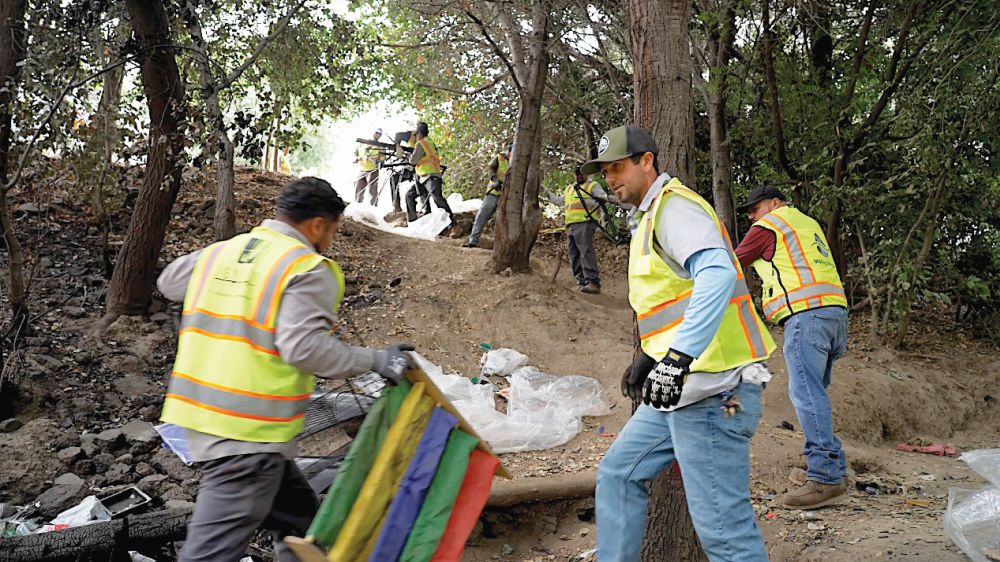Over the last decade, the Santa Clara Valley Water District has continued to spend more money on cleaning up homeless encampments around Silicon Valley.
Back in Fiscal 2013-14, the regional water wholesaler put $786,085 into the initiative. That grew to $1.5 million just a few years later, then dipped to a low of $364,896 during the first year of the pandemic.
This year it soared to new heights—costing the agency $2.4 million. That’s in addition to spending $403,594.60 on litter removal (down from $1 million last year, but still up from the $130,881 it put into the task in 2013-14).
Officials at the district, which manages 10 dams, say it’s a necessary part of ensuring residents have clean drinking water while contributing to the biodiversity of the Bay Area.
The agency has become responsible for cleaning up the mess left by illegal dumpers and the refuse generated as a result of NIMBYs using environmental laws to block housing construction across California.
“Unfortunately, when these items get into the creek, they do become dirty or contaminated,” said Jen Codianne, deputy of watershed operations and maintenance at Valley Water. “They do need to be removed.”
Encampment cleanups are funded by the “Safe, Clean Water and Natural Flood Protection” Measure S, which was approved by 75% of voters in 2020.
Valley Water takes care of 300 acres, attempting to prevent trash and other debris from polluting rivers and streams. It’s currently expanding its army of trash eliminators.
“We’re going to manage two encampment cleanup crews,” Codianne said. “We’re experts at this by now.”
The integrated effort includes internal staff, contract laborers and contributions from other agencies.
For example, Valley Water signed a $200,000 contract with San Jose, in 2019, to pay for police patrols along waterways like Coyote Creek and the Guadalupe River. It topped this up with a $400,000 agreement in 2021 for SJPD to police Coyote Creek Trail.
On Aug. 21, the riverside cleanup force was on full display in Los Gatos, as the Valley Water-led team descended on Los Gatos Creek—between Lee Avenue and Bascom Avenue.
“This actually is just part of our general routine maintenance,” Codianne said. “It’s really amazing to see these guys work.”
The crew forms a human chain, combing through the sloped earth, picking out the puzzle pieces that don’t belong. “They work really well together,” she said. “It’s complicated terrain. Sometimes it’s dangerous.”
Over three days they removed 9.07 tons of encampment-related trash from the site.
Valley Water explains that, just as waste management companies go door-to-door picking up trash from the homes of housed residents, it’s now the garbage-disposal service for the unhoused.
“When you look at the numbers, your first thought is, What if all this trash entered the waterways? Where would we be then?” she mused. “It’s an incredible amount of work that we’re doing to make sure the waterways are as clean as they can be.”
They work hand-in-hand with municipalities and have a team of biologists who are part of developing cleanup strategies. “We have to ensure we’re not harming any fish or wildlife,” she said. “They’re looking for nesting birds. They’re looking for endangered species.”
Some of these animals include the harvest mouse and Ridgeway’s rail in the tidal marshes along the San Francisco Bay, and the California red legged frog and California tiger salamander in Los Gatos Creek. And, Codianne adds, salmon can even be spotted, at times, in parts of that creek.
Codianne wants to make sure human activity doesn’t disrupt the natural life-cycle of these animals. “It’s natural in the creek channel to have downed trees that have fallen in,” she said.
When human debris comes into the picture, it can compound the challenges faced by animals. “It’s blocking the wildlife from their habitat,” Codianne said, describing this particular landscape scourge as a “trash raft.”
“That’s what we’re trying to avoid happening,” she said.
It’s not just the physical movement constriction that they’re worried about. Officials are also concerned about elements of the world being poisoned or choked by human waste. “Plastics can break down,” she said. “Sometimes wildlife can eat them mistakenly.”
To get all the junk out of the natural landscape, sometimes they have to call in the big guns—hauling a trash compactor to the site or deploying a skid steer.
“Sometimes you even have a crane,” Codianne said, commending the lower-level workers for their contributions, too. “They’re handing trash off one-to-another,” she said.
Beyond aiding the animals and protecting their water distribution chain, funding homeless encampment cleanups has an additional benefit—preventing flooding.
“There’s potential for that,” Codianne said. “We really want to make sure that the debris isn’t blocking…any of these flood-protection structures.”
Recently, Los Gatos stepped up its homeless outreach program. The Town has already established a portable toilet downtown and is planning for a longer-term public restroom facility.
It’s also developing an emergency hotel voucher program and has increased funding for a shower program, so residents can clean themselves twice a week in proper facilities (instead of just once).
Codianne says projects like these from their partners are really helpful.
“We really appreciate all the city efforts,” she said, noting they also have a portable restroom program, which is funded by an Environmental Protection Agency grant. “We all really do our part, and do it as best as we can.”
But will all this taxpayer money that’s now directed to homeless services and environmental protection make a difference?
“I’m very optimistic,” she said. “Obviously there are a few things that are up against us.”
She’s referring to the intense economic hardship faced by so many Silicon Valley residents, despite the massive wealth generated by many technology companies during the pandemic work-from-home boom.
“The amount of people falling into homelessness keeps increasing,” she said. “It’s hard for the community to see the benefits right now. But I think as long as we keep coming up with new initiatives and collaborating, hopefully sometime soon…we’ll see the difference.”



